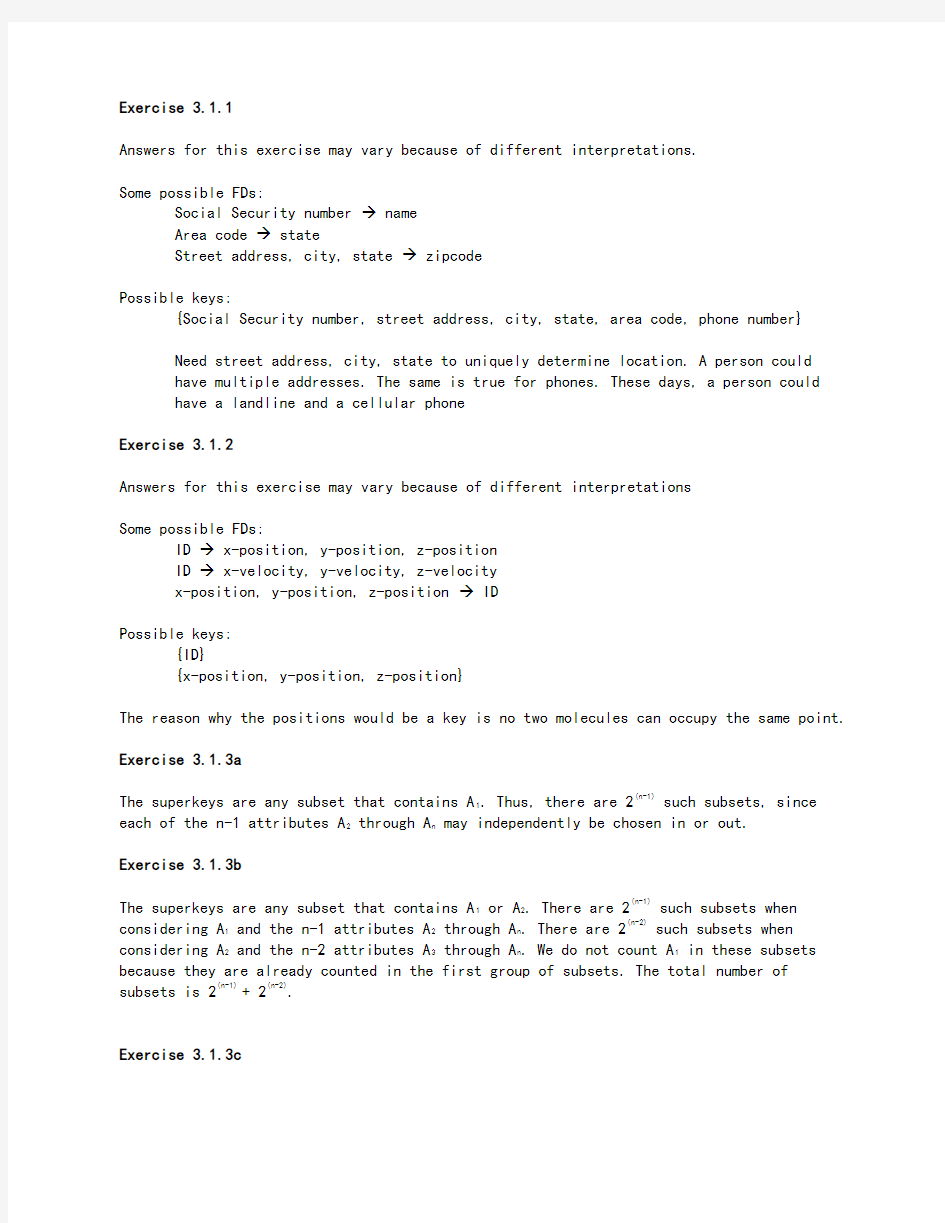数据库系统基础教程第三章答案

- 1、下载文档前请自行甄别文档内容的完整性,平台不提供额外的编辑、内容补充、找答案等附加服务。
- 2、"仅部分预览"的文档,不可在线预览部分如存在完整性等问题,可反馈申请退款(可完整预览的文档不适用该条件!)。
- 3、如文档侵犯您的权益,请联系客服反馈,我们会尽快为您处理(人工客服工作时间:9:00-18:30)。
Exercise 3.1.1
Answers for this exercise may vary because of different interpretations.
Some possible FDs:
Social Security number → name
Area code → state
Street address, city, state → zipcode
Possible keys:
{Social Security number, street address, city, state, area code, phone number}
Need street address, city, state to uniquely determine location. A person could
have multiple addresses. The same is true for phones. These days, a person could
have a landline and a cellular phone
Exercise 3.1.2
Answers for this exercise may vary because of different interpretations
Some possible FDs:
ID → x-position, y-position, z-position
ID → x-velocity, y-velocity, z-velocity
x-position, y-position, z-position → ID
Possible keys:
{ID}
{x-position, y-position, z-position}
The reason why the positions would be a key is no two molecules can occupy the same point.
Exercise 3.1.3a
The superkeys are any subset that contains A1. Thus, there are 2(n-1) such subsets, since each of the n-1 attributes A2 through A n may independently be chosen in or out.
Exercise 3.1.3b
The superkeys are any subset that contains A1 or A2. There are 2(n-1) such subsets when considering A1 and the n-1 attributes A2 through A n. There are 2(n-2) such subsets when considering A2 and the n-2 attributes A3 through A n. We do not count A1 in these subsets because they are already counted in the first group of subsets. The total number of subsets is 2(n-1) + 2(n-2).
Exercise 3.1.3c
The superkeys are any subset that contains {A1,A2} or {A3,A4}. There are 2(n-2) such subsets when considering {A1,A2} and the n-2 attributes A3 through A n. There are 2(n-2) – 2(n-4) such subsets when considering {A3,A4} and attributes A5 through A n along with the individual attributes A1 and A2. We get the 2(n-4) term because we have to discard the subsets that contain the key {A1,A2} to avoid double counting. The total number of subsets is 2(n-2) +
2(n-2) – 2(n-4).
Exercise 3.1.3d
The superkeys are any subset that contains {A1,A2} or {A1,A3}. There are 2(n-2) such subsets when considering {A1,A2} and the n-2 attributes A3 through A n. There are 2(n-3) such subsets when considering {A1,A3} and the n-3 attributes A4 through A n We do not count A2 in these subsets because they are already counted in the first group of subsets. The total number of subsets is 2(n-2) + 2(n-3).
Exercise 3.2.1a
We could try inference rules to deduce new dependencies until we are satisfied we have them all. A more systematic way is to consider the closures of all 15 nonempty sets of attributes.
For the single attributes we have {A}+ = A, {B}+ = B, {C}+ = ACD, and {D}+ = AD. Thus, the only new dependency we get with a single attribute on the left is C→A.
Now consider pairs of attributes:
{AB}+ = ABCD, so we get new dependency AB→D. {AC}+ = ACD, and AC→D is nontrivial. {AD}+
= AD, so nothing new. {BC}+ = ABCD, so we get BC→A, and BC→D. {BD}+ = ABCD, giving us BD→A and BD→C. {CD}+ = ACD, giving CD→A.
For the triples of attributes, {ACD}+ = ACD, but the closures of the other sets are each ABCD. Thus, we get new dependencies ABC→D, ABD→C, and BCD→A.
Since {ABCD}+ = ABCD, we get no new dependencies.
The collection of 11 new dependencies mentioned above are:
C→A, AB→D, AC→D, BC→A, BC→D, BD→A, BD→C, CD→A, ABC→D, ABD→C, and BCD→A.
Exercise 3.2.1b
From the analysis of closures above, we find that AB, BC, and BD are keys. All other sets either do not have ABCD as the closure or contain one of these three sets.
Exercise 3.2.1c
The superkeys are all those that contain one of those three keys. That is, a superkey
that is not a key must contain B and more than one of A, C, and D. Thus, the (proper) superkeys are ABC, ABD, BCD, and ABCD.
